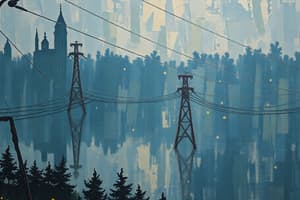Podcast
Questions and Answers
What is the relationship described by Ohm's Law?
What is the relationship described by Ohm's Law?
- Voltage is independent of current and resistance.
- Resistance affects current only when voltage is constant.
- Voltage, current, and resistance are interrelated. (correct)
- Current is equal to resistance multiplied by voltage.
Which measure is used to describe the speed of electrical travel?
Which measure is used to describe the speed of electrical travel?
- Ohms
- Volts
- Watts
- Amps (correct)
If the voltage is increased and resistance remains constant, what happens to the current?
If the voltage is increased and resistance remains constant, what happens to the current?
- It increases. (correct)
- It becomes zero.
- It decreases.
- It remains the same.
What does resistance measure in an electrical circuit?
What does resistance measure in an electrical circuit?
What is the correct formula that represents Ohm's Law?
What is the correct formula that represents Ohm's Law?
How is voltage measured?
How is voltage measured?
Which statement about resistance is true?
Which statement about resistance is true?
Which of the following correctly describes Ohm's experimental findings?
Which of the following correctly describes Ohm's experimental findings?
What is indicated by a higher voltage in a circuit?
What is indicated by a higher voltage in a circuit?
Why is Ohm's Law important in electrical studies?
Why is Ohm's Law important in electrical studies?
Flashcards
Voltage (V)
Voltage (V)
The force of an electrical current at the end of its path, measured in volts.
Current (I)
Current (I)
How fast or slow electricity travels in a given time, measured in amps.
Resistance (R)
Resistance (R)
The opposition to the flow of electricity, measured in ohms.
Ohm's Law
Ohm's Law
Signup and view all the flashcards
Ohm
Ohm
Signup and view all the flashcards
I = V/R
I = V/R
Signup and view all the flashcards
R = V/I
R = V/I
Signup and view all the flashcards
V = IR
V = IR
Signup and view all the flashcards
Water Hose Analogy
Water Hose Analogy
Signup and view all the flashcards
Water Hose Analogy for Voltage
Water Hose Analogy for Voltage
Signup and view all the flashcards
Study Notes
Ohm's Law
- Georg Ohm discovered the relationship between voltage, current, and resistance in electricity.
- His work, conducted from 1825 to 1827, led to Ohm's Law.
- Initially, this formula was not widely accepted by the scientific community.
- Later, the value of Ohm's work became clear, and his law became fundamental.
Key Terms in Ohm's Law
- Voltage (V): The force of an electrical current, measured in volts. Higher voltage indicates greater force. (e.g., Car battery > watch battery)
- Current (I): The speed of electricity flow, measured in amperes (amps).
- Resistance (R): How much a path resists the flow of electricity, measured in ohms. Wider pathways have less resistance (e.g., wider water hose).
Ohm's Law Formula
- The relationship between voltage (V), current (I), and resistance (R) is expressed as a formula:
- I = V / R
- R = V / I
- V = I × R
- These formulas allow you to calculate any of the three values, given the other two.
Analogy
- Wider water hose = Less resistance
- Water flowing through hose = Current
- Force of water exiting the hose = Voltage
Studying That Suits You
Use AI to generate personalized quizzes and flashcards to suit your learning preferences.




